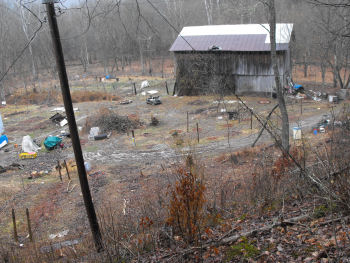
Planning a forest garden, part I
 For this week's lunchtime series, I thought
you all might enjoy seeing the initial planning stages for our new forest
garden. This photo shows the area we'll be working with ---
the worst part of our garden, full of weeds and waterlogged clay
soil. The book recommends first articulating our broad goals and
the specific factors we hope to use to achieve those goals, speaking in
the present tense from five or ten years in the future when our goals
have been met:
For this week's lunchtime series, I thought
you all might enjoy seeing the initial planning stages for our new forest
garden. This photo shows the area we'll be working with ---
the worst part of our garden, full of weeds and waterlogged clay
soil. The book recommends first articulating our broad goals and
the specific factors we hope to use to achieve those goals, speaking in
the present tense from five or ten years in the future when our goals
have been met:
My barnside permaculture is primarily an
orchard of fruit trees with a shrub and herb layer which rounds out the
ecosystem and promotes the growth of the trees. It is also a
tranquil nook which tempts me to relax and enjoy the outdoors in summer
and winter. As the herbs and shrubs expand, I use their
propagules to spread permaculture ideas into other garden areas,
experimenting as I go.
- Fruit trees fill the canopy and are the main source of long term maintenance work.
- 3 apples, 1 nectarine, 1 plum
- trellised grapes
- Although initial construction work is intense, long term ground level maintenance is minimized (ie. little or no mowing!)
- Perennial herbs and shrubs are chosen first for fertility,
nectary, and groundcover purposes to improve the poor soil, attract
beneficial wildlife, and outcompete invasives. Most species are
freely available from my garden or nearby woods.
- Wet areas are ditched to create wetlands with dry areas in
between.
- Deer are barred from entry.
- Fence, chicken moat, or thicket/hedge?
- Restful nook with winter sun and summer shade, near water.
- Outdoor picnic/work area near trailer with lawn or other high traffic, soft groundcover.
| This post is part of our Planning The Forest Garden lunchtime series.
Read all of the entries: |
Want more in-depth information? Browse through our books.
Or explore more posts by date or by subject.
About us: Anna Hess and Mark Hamilton spent over a decade living self-sufficiently in the mountains of Virginia before moving north to start over from scratch in the foothills of Ohio. They've experimented with permaculture, no-till gardening, trailersteading, home-based microbusinesses and much more, writing about their adventures in both blogs and books.
Want to be notified when new comments are posted on this page? Click on the RSS button after you add a comment to subscribe to the comment feed, or simply check the box beside "email replies to me" while writing your comment.
RSS
comment 1
What is a chicken moat?
Comment by
Sheila
— Mon Mar 2 19:13:48 2009
- Remove comment
chicken moat
All shall be explained on Friday.... Stay tuned. 

Comment by
anna
— Tue Mar 3 08:53:24 2009
- Remove comment
Add a comment
